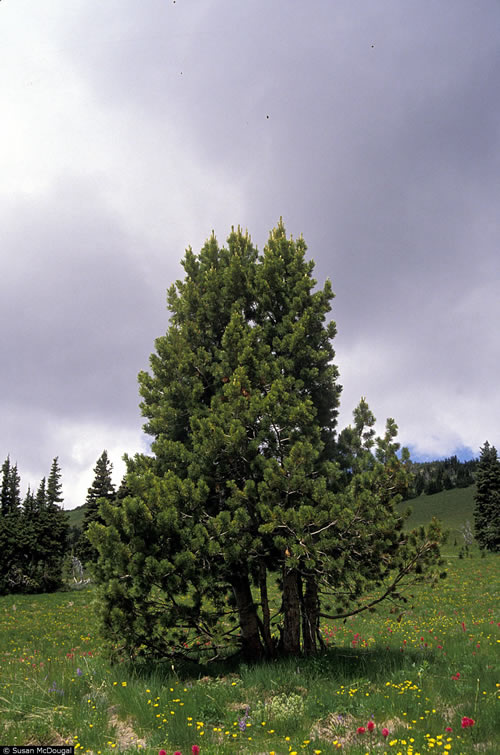
The whitebark pine carries a distinctive rounded top. Photo from the U.S.F.W.S.
Our Endangered Whitebark Pines
By Larry Hyslop

The whitebark pine carries a distinctive rounded top. Photo from the U.S.F.W.S.
The U.S. Fish and Wildlife Service have declared the whitebark pine warrants protection under the Endangered Species Act. Some mountains across the West have lost 80% of their whitebark pines. The main threats to this pine species come from a foreign fungus called “white pine blister rust” and the mountain pine beetle.
The problems faced by whitebark pines could significantly affect us locally. Whitebark pines grow only at high elevations among Coastal and Rocky Mountain ranges, usually forming a narrow band right at timber line, the highest elevations that can support trees.
The Ruby Mountains are unique since whitebark pines dominate the entire mountain range. Pinon pines low on the slopes, and limber pines usually grow slightly lower in elevation than whitebark pines, although there are many more whitebark pines than limber pines. At the End of the Road in Lamoille Canyon, whitebark pines make up most of the pines within view. At Angel Lake in the East Humboldt Range, the visible trees are whitebark and limber pines.
On July 18, 2011, the U.S. Fish and Wildlife Service said although the whitebark pine warrants protection under the Endangered Species Act, it is precluded by other listings of higher priority. They gave it a listing priority number two, meaning the threats are of high magnitude and imminent. In comparison, last year the Greater Sage-grouse was assigned the number eight in its precluded listing.
Other reasons given for the need to list whitebark pines include habitat loss, catastrophic fires, wildfire suppression and climate change.
In the past, harsh winters have contained the mountain pine beetle populations but they are attacking many more trees now. While individual trees might survive, it is feared whitebark pines on a landscape scale could become extinct within two to three generations. A generation is figured at approximately 60 years.
Julia Richardson is a Vegetation Management Specialist with the Humboldt-Toiyabe National Forest. She told me blister rust has been found in Lamoille Canyon. She worked on a project where a team gathered pine cones from what appeared to be blister rust resistant trees. The seeds from these cones will be tested for true resistance. If they are, the seeds could be invaluable in reseeding areas.
Gail Durham is a Forest Health Specialist with the Nevada Division of Forestry and has documented mountain pine beetles in Lamoille Canyon. Since whitebark pines fight bark beetles with sap, a good moisture year like this one should help the trees fight off the beetles.
She has also seen dwarf mistletoe in whitebark and limber pines around Angel Lake. Mistletoe kills both limber and whitebark pine trees. Trees that survive have lower vigor, produce fewer pine cones and are more susceptible to beetle damage.
Given the whitebark pine’s dominance in the Rubies, loss of these trees could result in fewer pines for visitors to enjoy.
Elko Daily Free Press, “Nature Notes”, 9/15/2011 © Gray Jay Press, Elko, NV
Return to Elko Nature Notes